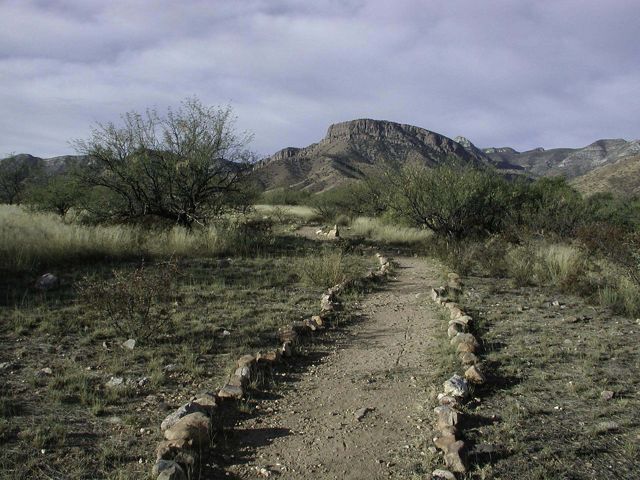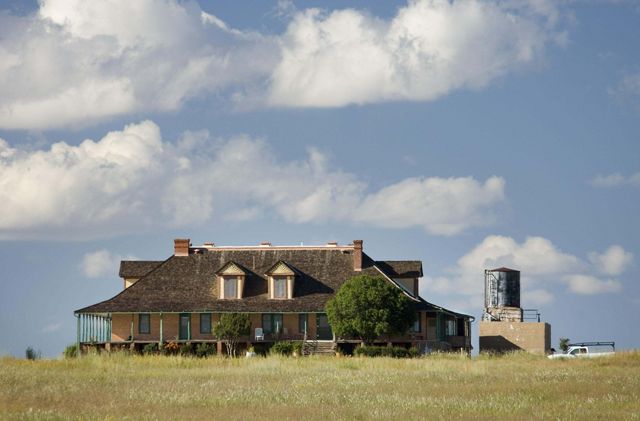Earth Day Reflections
You might have heard of the following places, but you might not know that we've helped to protect them.
Earth Day is a time of celebration and reflection. As proud as The Nature Conservancy in Arizona is of all the ecological progress in motion today, we would be remiss if we didn’t stop and appreciate the legacy of work that we built our organization upon. The projects over the last 57 years bolster and inform us to this day.
Here we present a small sample of the partnerships, negotiations, discoveries—and even some clandestine blindfolding—that TNC has been a part of in our multi-decade journey to protect and restore this amazing state of Arizona.

Cross F Ranch
For decades, the Cross F Ranch of Graham County was the access point to explore approximately 40,000 acres of public land. Situated between Aravaipa Canyon Wilderness and Santa Teresa Wilderness, the site was also an entryway to one of Arizona’s vital wildlife corridors.
Generously, the owners of the Cross F left their property unlocked so the general public could reach the lands managed by the Bureau of Land Management and the U.S. Forest Service (respectively). But when the ranch changed hands, so did the open-door philosophy. The new proprietor shut down access, cutting people off from their own public lands for nearly 20 years.
When the owners made it known that they were looking to sell the land for possible development and subdivision, The Nature Conservancy and other groups across Arizona, came together to negotiate and fund a complex conservation deal to protect the property. After purchase, most of the land was entrusted to the Bureau of Land Management to be included in the TNC-supported Aravaipa Ecosystem Management Plan. Thanks to the many partners involved, the public land is now back in its rightful owners’ hands—the people of Arizona.

Yavapai-Apache Nation land transfer
In 2008, The Nature Conservancy purchased a small property called “Otter Waters” on the Verde River in Camp Verde. The intent was to protect the 20-acre riparian corridor for the immediate time being and transfer the property to Arizona State Parks or a federal agency when possible. But funding and capacity issues kept Otter Waters under TNC’s ownership.
Meanwhile, TNC’s water programs in the Verde River area provided an opportunity to open a relationship with the Yavapai-Apache Nation, as they worked together to improve irrigation efficiency and convert existing crops to more water-conscious yields. Through these projects, TNC and the Yavapai-Apache Nation were in a position to discuss the relinquishment of Otter Waters, a part of the historic Camp Verde Indian Reserve, back to the nation without any monetary compensation. In 2023, TNC closed on the first transfer of property to a tribal entity.
The property will now be used by the nation for river access, minor recreation, ceremonial purposes and the continued protection of Verde River’s natural state. They also assume the instream flow rights that TNC initiated, which grant them more power to protect and maintain the river.
“Although relatively small in acreage, this project is huge in terms of its importance and speaks to years of perseverance and relationship building. Just as the Verde and Protection teams did excellent work managing Otter Waters for many years for conservation outcomes, they have now done a great job in transferring ownership to a valued partner who can better and more meaningfully use this site in perpetuity.” –TNC Arizona State Director Dan Stellar

Kartchner Caverns
Discovered at the base of the Whetstone Mountains by Gary Tenen and Randy Tufts in 1974, the Kartchner Caverns were immediately recognized as special. The kind of special to keep quiet about to protect them from unregulated damage. Little did Tenen and Tufts know, this secrecy would result in 29 years of clandestine meetings, covert negotiations and unforeseen challenges.
The explorers kept their discovery to themselves for four years, not even telling the owners of the property, James and Lois Kartchner, until 1978. For a while, Tenen and Tufts thought of developing the caves for public use by themselves. But members of the Kartchner family were impressed with the work done by Arizona State Parks, and all parties agreed that the best way forward would be to contact the agency instead.
Nicknamed “Xanadu” and “Secret Cave,” Tenen and Tufts continued to insist on the utmost secrecy when involving new people in the project and would only present what they had discovered via in-person visits requiring blindfolds, misdirection and spaces tight enough to get stuck in. In spite of the extensive obstacles, Arizona State Parks was very interested in acquiring the caverns.
Arizona’s governor was informed about the site and taken on a tour soon after. Governor Babbitt, a geology major back in the day, quickly recognized the value of the property and brought in The Nature Conservancy to provide the vital bridge funding needed for the purchase. Eventually, a bill approving the acquisition of Kartchner Caverns passed through both the Arizona House of Representatives and Arizona Senate on the same afternoon in 1988. It would still take another 10 years of planning, legislation, mining and legal challenges, however, before the upper caverns could finally open to the public in 1999, followed by the lower caverns in 2003.

Hassayampa River Preserve
The Hassayampa River flows mostly underground, from its source near Prescott on down south to join the Gila River. But for five miles on that run, in an area just south of Wickenburg, the granite bedrock domes up and pushes a year-round water flow to the surface.
The Hassayampa River Preserve encompasses 770 acres along this water way. The area was once home, at various times in its history, to the first carp farm in Arizona, a stagecoach station, a railroad station, fruit trees, cattle and a dude ranch known as “Garden of Allah,” named after a popular book at the time. Unfortunately, it eventually deteriorated into a poorly maintained habitat and trailer park.
But 1974 brought new owners, Norman and Dorothy R. Lykes, who saw the environmental value of the land. They tended to its restoration themselves before selling 330 acres to The Nature Conservancy in 1986. TNC spent another year rehabilitating the property and opened it to the public in 1987. Dorothy donated more land to the preserve shortly before her death in 2004, nearly doubling the property in size and completing the Lykes’ vision of reuniting lands on both sides of the railroad tracks. Maricopa County and TNC entered into an agreement in 2017, giving the county management over the property.

San Rafael Ranch
A mile and a half north of Lochiel, AZ sits a historic cattle ranch that was not only used for filming movies such as Oklahoma but was also successful enough to catch the social bandit Pancho Villa’s eye on more than one occasion.
In the ’90s, the Sharp family, owner of the 22,000-acre San Rafael Ranch, started to look into protecting the property from eventual subdivision and development. By 1998, the family had a purchase agreement with Arizona State Parks, but at the last minute, they had to withdraw due to tax issues. They had no choice but to list the property on the open market.
Fortunately, The Nature Conservancy stepped in with a solution. Through the acquisition of all shares of the family corporation, they were able to negotiate the purchase themselves, freeing the family of the tax implications. Thanks to TNC’s involvement, the property was able to come under conservation easement with Arizona State Parks. TNC retained a small portion of the property as well under conservation easement, to allow them to continue as a partner in the protection of the San Rafael Valley.

Shield Ranch
Shield Ranch was one of the first farms in the Verde Valley and a pioneer in irrigation ditch use in the area. And due to Arizona water rights, the property maintains priority right to the water flow on the Verde River to this day.
In 2010, The Nature Conservancy purchased 300 acres of the ranch to secure the precious water rights for conservation purposes and to prevent development.
Soon after, TNC proposed a new idea to the Hauser family, local multi-generational farmers who were already partnering with TNC on other water conservation projects like solar-powered ditch gates. They asked the Hausers to turn Shield Ranch into test grounds for the production of malted barley, a winter crop that utilized a fraction of the water needed for more traditional Verde Valley crops like alfalfa.
The first 15-acre test was a resounding success, and production quickly stepped up to 150 acres the next season and then 433 acres around the valley a few years later. Verde Valley continues to provide Sinagua Malt, Arizona’s first commercial malthouse, with highly regarded barley malt used in commercial and home breweries across Arizona.

Babocomari Ranch
Once owned by the King of Spain, the Babocomari Ranch was acquired by Frank Cullen Brophy in 1935. Even this early in the century, Brophy recognized the threats from overgrazing, drought and flooding that were present on the property and initiated conservation policies for the management of the land that are still used today.
Almost 100 years later, more than 60 direct descendants of Brophy are current members of a family partnership committed to preserving 18,000 acres central to the ranch. These third- and fourth-generation Brophys have collaborated with The Nature Conservancy to eventually place 16,000 acres of the property into conservation easements with the Bureau of Land Management. 3,300 acres have already been allocated, and work continues to place the rest into easements that will help Frank Cullen Brophy’s vision of protection and conservation persevere.
It is this legacy that we will carry into the next 60 years as we continue to work with partners and supporters to take meaningful actions to inspire positive change to protect Arizona’s natural treasures.
The Nature Conservancy is a global conservation organization dedicated to conserving the lands and waters on which all life depends. Guided by science, we create innovative, on-the-ground solutions to our world’s toughest challenges so that nature and people can thrive together. We are tackling climate change, conserving lands, waters and oceans at an unprecedented scale, providing food and water sustainably and helping make cities more resilient. The Nature Conservancy is working to make a lasting difference around the world in 81 countries and territories (40 by direct conservation impact and 41 through partners) through a collaborative approach that engages local communities, governments, the private sector, and other partners. To learn more, visit nature.org or follow @nature_press on X.
